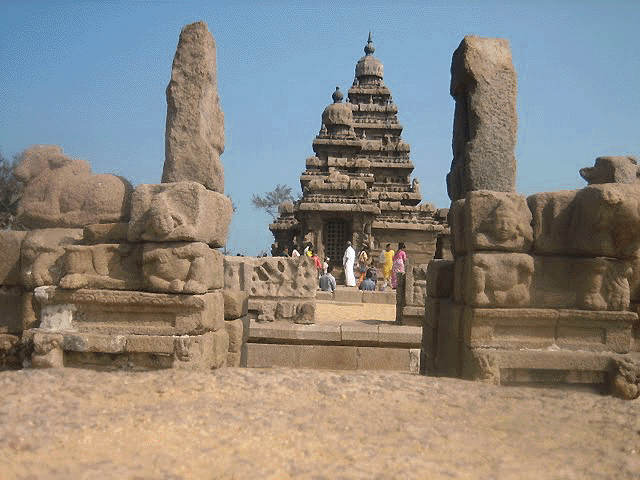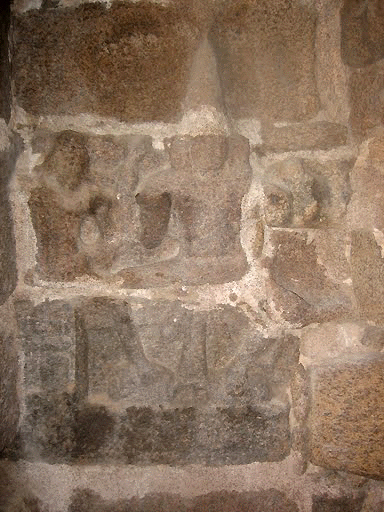
|
|
|
|
Lord Brahma resides in one of these three temples, which include a Shiva temple with a small tower, a Shiva temple with a larger tower, and in between them, a small Visnu shrine known as Anantashayi Vishnu. The biggest Shiva temple faces the east, and on the inner wall of its ardha-mandapa, on the south side, is a beautiful wall panel sculpture of Lord Brahma, shown with three heads. Even though these temples and murtis were carved from granite, time, sand, and the elements have worn them down, as this Brahamdeva sculpture clearly shows.
Before moving on to the Atiranachanda temple, let's consider for a moment the techniques used by the architects and artists who excavated and carved these extraordinary temple monuments. Rather than working with quarried and transported blocks like most structural temples are built from, these artists carved the Mahabalipuram temples from solid boulders, found on the spot. Being unable to position the blocks so that the carver can work in a comfortable position, the rock-cut temple artisans had to squat, crawl, or stand on scaffolding. Avoiding errors were mission critical, since a badly carved block could not simply be replaced.
The sculptors began by selecting choice boulders, then roughing them in, removing large chunks that didn't fit the design. Wall surfaces were flattened and eventually finished, and all the various architectural elements were painstakingly carved. While sculpting in softer stone like sandstone or laterite, one might use a variety of tools for the job, but in granite, the chisel and hammer were used for the entire process.
Large chunks of unwanted rock were removed by making a series of square holes all along the intended break line. These were sunk to a depth of three or four inches. Wedges were then inserted in each hole, and men with sledgehammers, who were known as kal-uli-maangan, simultaneously hammered each of the wedges until the rock broke free. The clean, smooth surfaces produced by this method are quite amazing.
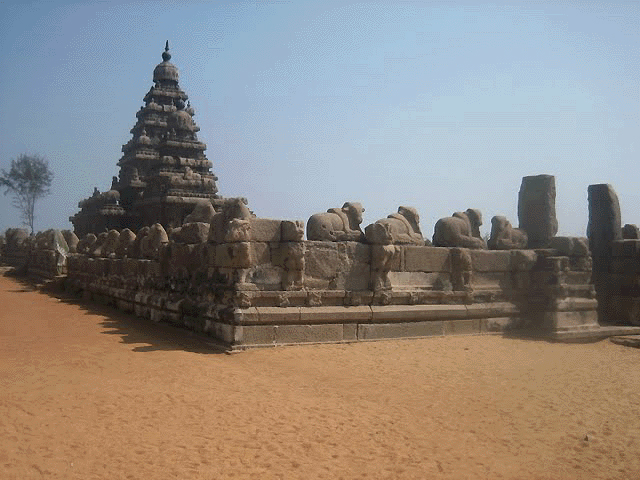
Shore Temple When sculpting the great bas-relief panels like those above and below featuring Lord Brahma, the artist first cut deep grooves in a pattern. Holding chisels at an angle in these cuts, striking them with hammers, chunks were separated from the desired image. Even the fine finishing was done with chisels and hammers. Controlled strokes for the final roughing-in process were done by evening out (kodutal and karaittal), while surfaces were smoothed using light pecking strokes with a pointed chisel (pozhital or pozhichchal). The finishing strokes were done with a flat chisel having prick-like dentures (palamunai). Chisels had to be tempered frequently on the job site, and the work was generally very slow going.
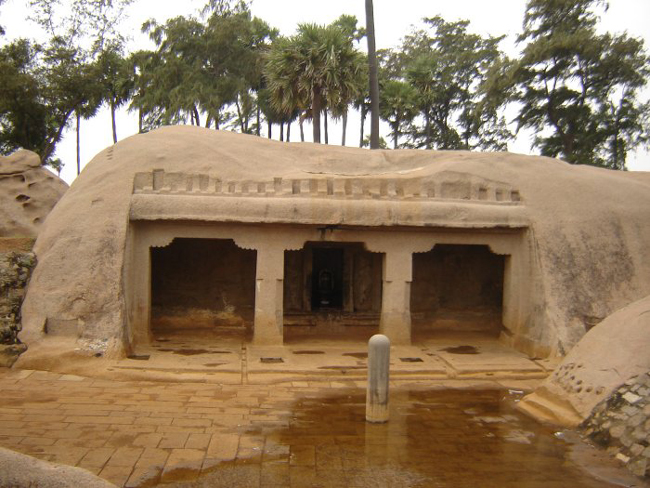
Atiranachanda Mandapa
The Atiranachanda mandapam of Rajasimha is the last temple in the rock-cut series from Mahabalipuram that houses a predominant figure of Lord Brahma. Atiranachanda is located in Saluvankuppam, near the heart of the Mahabalipuram region, in the Chingleput district of Tamil Nadu. An inscription on the central beam of the facade refers to the temple as Atiranachanda-ishvara griha, named after Atiranachanda Pallava, or Rajasimha. Another inscription, on the floor of the mandapa, records the gift of sheep for a perpetual lamp in the temple. The Atiranachanda cave is rectangular, with simple Pallava style pillars, having a central sanctum sanctorum excavated from the rear wall. Two dvarapalas guard the sanctum door. There is a bas-relief panel of Shiva as Somaskanda, the presiding deity at Atiranachanda. In the panel, we see Shiva sitting with his consort Uma, their child Skanda perched on Uma's lap, and Nandi beside. Brahma and Vishnu are standing on either side of the family. Brahmadeva is on the left side, with three faces, and Visnu on the right. This depiction of Brahma and Visnu worshipping Somaskanda is a siddhantic view of the main deity.
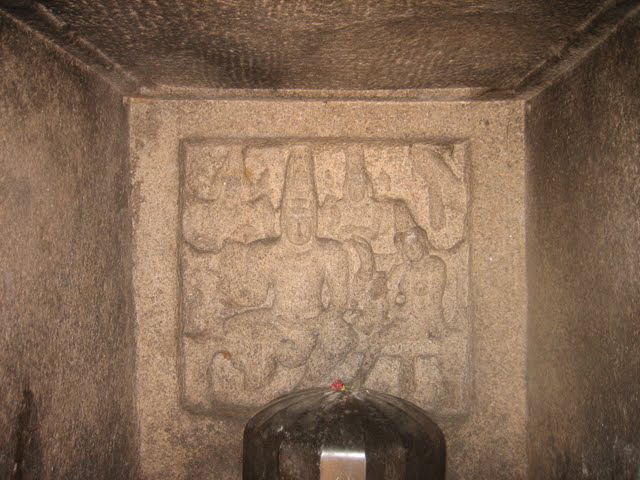
Lord Brahma in Somaskanda panel Sitting in front of the panel is a Shiva-lingam, the upper portion of which is called the puja-bhaga. The incised lines culminate in a flame-like emblem, probably in the form of a jyotir-linga. There are two lingams of this type now installed at Atiranachanda, and they are known as prismatic lingams because of the way light plays on the incised surfaces. These black polished, fluted, sixteen-sided linga (dhara-linga) are very imposing.
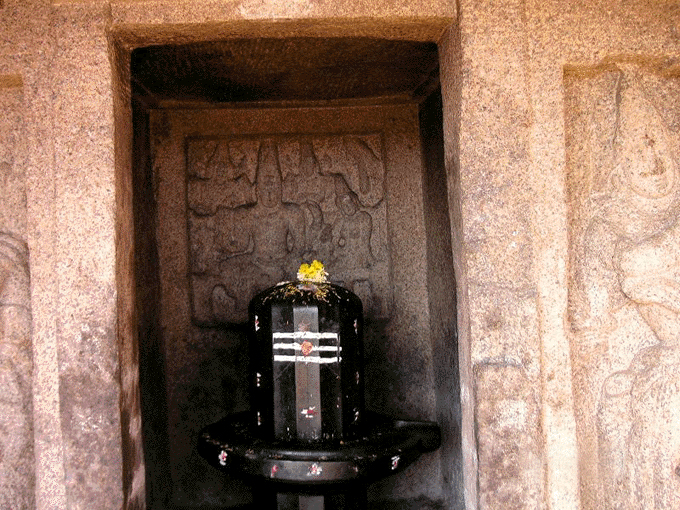
Prismatic linga before Somaskanda panel The Somaskanda panel shown here is very similar to one we saw yesterday, also depicting Somaskanda and family with Lord Brahma and Visnu. This one was at the Mahishasur-Mardini shrine. Two more such Somaskanda reliefs are found carved on the rear mandapa wall of Atiranachanda, and there has long been a debate amongst historians as to the intent behind three identical panels. When this temple was constructed, there were likely no lingams in the temple. The wall panels themselves were understood to be an embodiment of the temple deities, and worship was offered to them directly. The lingams were a later addition. Looking for clues to the mystery of the three panels, the editors of www.PoetryInStone.in discovered an old British Museum photo of the temple's excavation. It shows that there were three lingams installed at that time (late 18th century), although two have long since disappeared. Each linga sat before one of the three panels of Somaskanda, Brahma and Visnu.
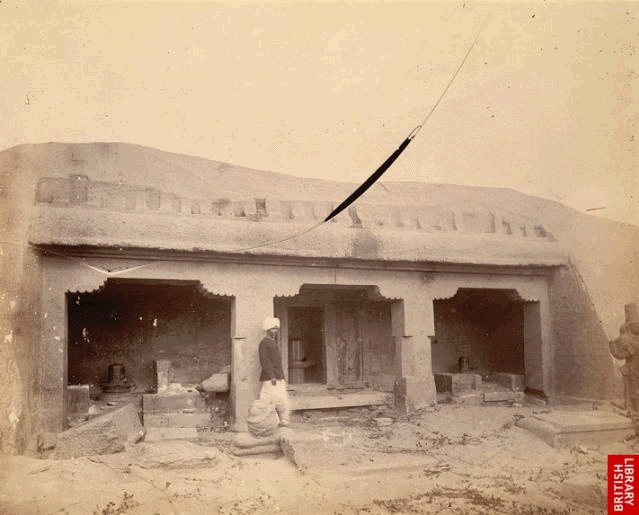
Freshly excavated Atiranachanda mandapa with three lingams before Somaskanda panels To our knowledge, this is the only temple where three nearly identical images of Lord Brahma are all found within the same sanctum precinct, making it a "trimurti" of an altogether different sort. Of course, it's possible that this was meant to be a Trimurti temple, with an identical panel dedicated to each of the three divine personalities: Shiva-Somaskanda, Brahma and Visnu. The recently discovered buried monument mentioned in yesterday's segment, which came to notice after the deadly 2004 Tsunami, is just beside the Atiranachanda mandapam. The structure is now being excavated, but a set of inscriptions have already been found which identify this as a Subrahmanya temple. Two granite pillars were quickly unearthed, and they carried the inscription. The site is dated to the reign of Pallava kings Dandivarman (813 AD) and Nandivarman III (about 850 AD). It appears that the temple is completely in ruins, and may have collapsed in disrepair.
| |
